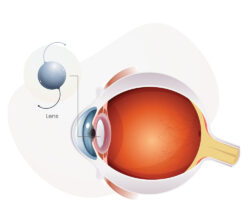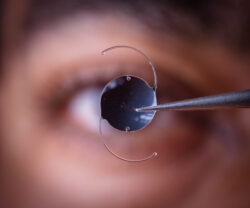ORA System: Laser Guided Technology for Cataract Surgery
 Wiles Eye Center prides itself in utilizing the most advanced technology and methods to help our cataract patients achieve optimum vision. We are pleased to offer Optiwave Refractive Analysis (also known as the ORA System), a new and innovative technology system that allows our doctors to create customized treatment plans for more precise correction during cataract surgery.
Wiles Eye Center prides itself in utilizing the most advanced technology and methods to help our cataract patients achieve optimum vision. We are pleased to offer Optiwave Refractive Analysis (also known as the ORA System), a new and innovative technology system that allows our doctors to create customized treatment plans for more precise correction during cataract surgery.
What is the ORA system?
The ORA System is an intra-operative guidance technology that allows surgeons to get an accurate measurement of the patient’s eye-focusing capacities during surgery. In the past, cataract patients had to undergo comprehensive evaluations before and after the procedure to determine which premium intraocular lens implant (IOL) was best for them. Unless treated with the ORA System, patients still typically need to wait several weeks after cataract surgery to confirm their quality of vision with their new IOL. The Optiwave Refractive Analysis (ORA) System allows our surgeons to verify that patients are receiving the best IOL for their needs in “real time” during surgery. This new technology measures the eye’s unique optical characteristics, allowing for optimal IOL positioning during surgery. With the ORA System, the surgeon can make any necessary adjustments to the IOL at the time of the surgery, reducing the possibility of the patient needing to undergo an additional procedure at a later time.
Additionally, the ORA System can help enhance vision results in astigmatic patients as well as those that previously underwent LASIK or PRK. Eyes that have undergone laser vision correction surgery are difficult to measure accurately, making it even more difficult to determine which lens implant is appropriate. The ORA System has been clinically proven to significantly increase the accuracy of lens power selection in these patients during cataract surgery. The system has also been clinically proven to improve the accuracy of toric IOL placement and reduce the need of prescription eyeglasses after surgery.
 Cataract surgery is one of the most common — and successful — procedures performed today. ORA technology enhances the success of cataract surgery. With the ORA System, patients can achieve better, more precise results during surgery, as well as higher quality of vision.
Cataract surgery is one of the most common — and successful — procedures performed today. ORA technology enhances the success of cataract surgery. With the ORA System, patients can achieve better, more precise results during surgery, as well as higher quality of vision.
ORA Guided Cataract Surgery Reviews
“If you ever need eye surgery, Wiles Eye Center is the place to go. Always willing to answer questions and explain procedures. I’d rate them higher if I could.” – Google Reviewer
“Great experience! All very helpful, I can see so much better!” – Healthgrades Reviewer
“I have received quality care from Dr Wiles, Dr Klein and the entire staff at Wiles Eye Center. Always friendly, professional and take the time to explain procedures and answer any questions.” – Google Reviewer
Benefits of ORA
The ORA system provides many benefits when used in tandem with your vision correction procedure.
Better Results: The Ora System provides better results by assisting your surgeon.
More Confidence: ORA provides your surgeon with an additional confirmation of measurements.
Extra Benefits: For patients with astigmatism, ORA improves accuracy, reducing the chance of requiring patients to wear eyeglasses after their surgery.
Frequently Asked Questions about the ORA System
Is the ORA System Necessary for Cataract Surgery or Laser Guided Cataract Surgery?
No, the ORA system is not necessary for standard cataract surgery and/or laser-guided cataract surgery. However, it can significantly streamline and enhance the procedure and the outcomes the patient will experience. By confirming the eye’s correction needs in real time and providing the surgeon information that may not have been available during pre-operative analysis, the ORA system can help to deliver a higher quality of post-operative vision than previously available with all current cataract surgery procedures.
Real-time data verification allows the surgeon to validate or refine the surgical plan as needed and make any adjustments on the spot.
For example, once the natural lens has been removed and the artificial lens has been implanted in its place, the surgeon analyzes the entire structure of the eye’s optical system. Based on the information he collects, he can decide to adjust the power of the artificial lens or the placement of the lens to achieve the sharpest visual results. Or, the surgeon may opt to use a new lens altogether to achieve better results.
This type of real-time, accurate information reduces the likelihood that adjustments will be needed later (i.e., weeks after surgery, once vision can be measured). It also improves the chances of reducing or eliminating the need for glasses after cataract surgery.
How Long Does Cataract Surgery Take With the ORA System?
A cataract surgery procedure with ORA technology may take slightly longer than cataract surgery performed without the technology. However, most patients are very willing to trade a few extra minutes in the operating room for sharper, more precise visual outcomes.
Are There Any Risks?
Since the ORA system does not make contact with the eyes, it does not increase the risks of cataract surgery. However, it should always be performed by a qualified cataract surgeon that has experience with the technology.
Is There Anything That Could Rule Me Out as a Candidate?
The ORA system can benefit virtually every cataract surgery patient. In fact, it may be particularly beneficial to patients that have had previous laser eye surgery, such as LASIK, PRK or radial keratotomy (RK), or patients with astigmatism who need toric IOLs or limbal relaxing incisions.
To discuss ORA-guided cataract surgery with our team, please request a consultation at Wiles Eye Center.
How Accurate Is the ORA System’s IOL Verification?
The ORA system is credited with producing more accurate, predictable outcomes from cataract surgery. According to Alcon, the company behind the ORA system, real-time data collection and verification enables cataract surgeons to position toric IOLs within one degree of accuracy.
Here’s even more evidence that the ORA system improves patient outcomes — particularly in post-LASIK and astigmatic patients:
In a study of previous LASIK patients, over 45 percent more patients fell within the desired refractive target range with ORA-guided cataract surgery, compared to those who had cataract surgery without ORA.
And, in a study of patients with astigmatism, the number of patients who fell outside their desired astigmatic target range was reduced by more than 50 percent in ORA-guided procedures, compared to those who had cataract surgery without ORA.
How does ORA technology improve cataract outcomes?
 The Optiwave Refractive Analysis system verifies your vision needs and measures your eye after the clouded lens (cataract) is removed when there is a clearer view. The detailed measurements taken with the ORA system tailor your cataract surgery results by analyzing your eye and letting our eye surgeons know if the IOL power needs adjusting or if another IOL would provide better vision. ORA technology during cataract surgery may reduce the risk of needing another procedure to improve vision or correct the IOL placement. This analysis system fine-tunes the IOL power and placement for the best visual outcome possible.
The Optiwave Refractive Analysis system verifies your vision needs and measures your eye after the clouded lens (cataract) is removed when there is a clearer view. The detailed measurements taken with the ORA system tailor your cataract surgery results by analyzing your eye and letting our eye surgeons know if the IOL power needs adjusting or if another IOL would provide better vision. ORA technology during cataract surgery may reduce the risk of needing another procedure to improve vision or correct the IOL placement. This analysis system fine-tunes the IOL power and placement for the best visual outcome possible.
Will it hurt when the ORA system takes measurements?
During cataract surgery, your eyes are numbed with anesthetic drops. While you may feel pressure during other parts of the procedure, the ORA system does not need to touch the eyeball to take measurements. The technology analyzes your eye while you look at a flashing light, so you should not feel anything during this process.
How does laser cataract surgery with the ORA system improve upon traditional cataract surgery?
Laser cataract surgery offers more reliable results with more precise and predictable incisions in the cornea and lens capsule. Laser energy is helpful for dense cataracts, which can complicate traditional cataract surgery because it’s more difficult for the surgeon to create a circular opening in the lens capsule when the lens is mature or hypermature (hard, stiff, and dense). The laser helps fragment the lens for easier removal and requires less ultrasound energy to break up the cataract, which may reduce corneal swelling.
The laser’s accuracy provides a more predictable correction of minor astigmatism by reshaping the abnormally curved cornea from an egg shape to more of a round ball. Astigmatism correction with traditional cataract surgery is performed by hand with limbal relaxing incisions.
Laser cataract surgery may make inserting and positioning the IOL easier due to consistent incisions, and using the ORA system ensures the correct IOL type, lens power, and position. The ORA system enhances the procedure and patient outcomes from laser cataract surgery by telling our eye surgeons if the IOL is in the ideal position for best-corrected vision. If not, the eye surgeon adjusts the IOL placement or lens power for optimal results. With the continuous assessment of the patient’s eye, the ORA system makes real-time suggestions for the IOL sphere, cylinder, and alignment.
What premium lenses are available with ORA technology?
 The ORA system can work with any IOL; the technology takes measurements that help our eye doctors determine the right fit for your needs and adjust as necessary. Monofocal lens implants are the default option for standard cataract surgery, and these IOLs correct for a single focal point (near or distant vision). Laser cataract surgery with a premium IOL offers better vision and less dependence on corrective eyewear because these lens implants correct for all refractive errors.
The ORA system can work with any IOL; the technology takes measurements that help our eye doctors determine the right fit for your needs and adjust as necessary. Monofocal lens implants are the default option for standard cataract surgery, and these IOLs correct for a single focal point (near or distant vision). Laser cataract surgery with a premium IOL offers better vision and less dependence on corrective eyewear because these lens implants correct for all refractive errors.
Our eye surgeons at Wiles Eye Center offer Tecnis Symfony, ReSTOR Multifocal, and Crystalens HD advanced lens implants. These brands also come with toric variations that correct astigmatism. Our eye doctors can determine which IOL is right for your needs during your consultation and confirm the chosen IOL is best with the ORA system.
Does the ORA system add time to my cataract surgery?
Cataract surgery with the ORA system may add a few minutes to your procedure, but the additional time is worth it for most patients. The procedure typically takes 10 to 20 minutes.
Schedule Your ORA Appointment Today
To learn more about the ORA System and cataract surgery, contact the Kansas City, MO eye care specialists at Wiles Eye Center.
